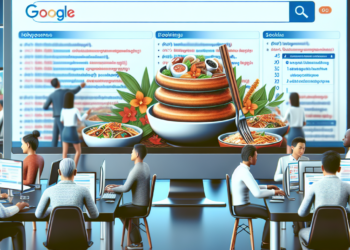Uncover the secrets of boosting your SEO with alt text! Learn how this simple strategy can revolutionize your online presence.

Image courtesy of via DALL-E 3
Table of Contents
Introduction to Alt Text
Hey there, have you ever heard of alt text? It might sound a bit fancy, but it’s actually quite simple and important for websites. Let’s dive in and learn all about it!
What is Alt Text?
Alt text, short for alternative text, is a hidden description that we can’t see but is used to explain images on websites. It’s like a secret code that helps people with visual impairments understand what an image is all about. It’s super cool because it makes the internet a more inclusive place for everyone!
Why is Alt Text Important?
Alt text plays a crucial role in making websites accessible to everyone, including those who use screen readers to understand web content. Imagine not being able to see a picture but hearing a description of it—it’s like painting a picture with words! Also, alt text helps search engines like Google understand the content of images, which can boost a website’s visibility and ranking. So, next time you see a website, remember that alt text is working hard behind the scenes to make sure everyone can enjoy it!
How Alt Text Helps in SEO
SEO stands for Search Engine Optimization. It’s like a magic trick that helps your website appear higher in search engine results when someone looks for something online. Think of it as a popularity contest where the best and most helpful websites win!
Role of Alt Text in SEO
Now, let’s talk about how Alt text plays a cool role in this magic trick. When search engines like Google scan a webpage, they can’t “see” images like we do. Alt text is like a secret message that tells search engines what the image is all about. This helps search engines understand your content better and can improve your chances of showing up in search results.
Creating Effective Alt Text
When it comes to enhancing the accessibility and search engine optimization of a website, creating effective Alt text plays a crucial role. Alt text, also known as alternative text, is a brief description added to an image on a webpage. These descriptions are not only valuable for visually impaired users but also boost the SEO ranking of the website. Let’s explore some strategies and tips for crafting meaningful Alt text.
Keep It Descriptive
Effective Alt text should be descriptive and provide a clear representation of the image it is describing. Instead of merely stating what the image is, strive to convey its purpose or significance. Keep the text concise but informative, allowing all users to grasp the essence of the image, even if they cannot see it.
Be Relevant
When creating Alt text, relevance is key. Ensure that the description directly relates to both the image itself and the content on the webpage. By aligning the Alt text with the overall context of the page, you not only improve accessibility but also signal to search engines the relationship between the image and the topic of the site.
Common Mistakes to Avoid
One common mistake to avoid when creating Alt text is overstuffing keywords. This means adding too many keywords in an attempt to boost search engine optimization. While it’s important to include relevant keywords, stuffing your Alt text with an excessive number of them can be harmful. Search engines may penalize your website for keyword stuffing, leading to lower rankings. It’s best to keep your Alt text concise and descriptive, focusing on the main content of the image.
Using Generic Text
Another mistake to steer clear of is using generic text in your Alt attributes. Generic or non-descriptive Alt text does not provide useful information to users or search engines. For instance, using phrases like “image” or “image123” as Alt text does not convey any meaningful context about the image’s content. Instead, aim to be specific and descriptive in your Alt text to enhance both accessibility and SEO. Describe the image accurately so that it complements the overall content of the web page.
Alt Text for Different Types of Images
Decorative images are those used solely for aesthetic purposes and do not convey any important information. When writing Alt text for decorative images, it is best to keep it simple and concise. You can describe the image briefly, such as “Floral pattern background,” without going into unnecessary detail. Remember, the Alt text should enhance user experience for those who rely on screen readers without cluttering the page with excessive information.
Informational Images
Informational images include charts, graphs, or diagrams that provide key details or data. When creating Alt text for informational images, focus on conveying the essential information presented in the image. Describe the content accurately, such as “Pie chart showing sales distribution by region.” This helps visually impaired users understand the significance of the image within the context of the webpage.
Complex Images
Complex images, such as infographics or detailed illustrations, require more thought when writing Alt text. For these types of images, break down the key components and describe them in a logical sequence. Provide a brief summary of the image’s main message and the relationships between different elements. Be mindful of conveying the essential information effectively without overwhelming the user with too much detail. Consider using bullet points to organize the Alt text for complex images.
Tools for Creating and Checking Alt Text
Alt text generating tools are handy resources that can help you automatically create descriptive text for your images. These tools analyze the content of your images and suggest suitable Alt text to improve web accessibility and SEO. Some popular Alt text generating tools include ImageSEO, Accessibility Checker, and Alt Text Generator. By using these tools, you can save time and ensure that your images are properly labeled for users and search engines.
SEO Checkers
SEO checkers are essential for verifying the effectiveness of your Alt text in boosting your website’s SEO performance. These tools analyze your Alt text and provide recommendations on how to enhance it for better search engine visibility. By using SEO checkers like Yoast SEO, SEMrush, and Moz Pro, you can optimize your Alt text to align with current SEO best practices. These tools also offer insights into keyword usage, readability, and overall SEO health of your content.
The Future of Alt Text in SEO
As we look ahead to the future of SEO and how Alt text fits into this ever-evolving landscape, it’s essential to consider the potential trends and advancements that may shape the way we approach image optimization. Let’s delve into the exciting possibilities that lie ahead.
Evolving SEO Practices
With search engine algorithms becoming more sophisticated and user-oriented, the role of Alt text in SEO is likely to become even more crucial. As websites strive to provide the best possible user experience, creating descriptive and relevant Alt text will continue to be a vital aspect of optimizing images for search engines.
Moreover, as the importance of accessibility in web design grows, Alt text will play a key role in making websites more inclusive and user-friendly. This shift towards inclusivity and user experience in the digital realm will further emphasize the significance of well-crafted Alt text.
AI and Alt Text
Artificial Intelligence (AI) is poised to revolutionize the way Alt text is generated and optimized. AI-powered tools can analyze images and automatically suggest relevant Alt text based on image content, context, and user intent. This automation can streamline the process of Alt text creation, making it more efficient and accurate.
Furthermore, AI can help improve the quality of Alt text by learning from patterns and user feedback. By continuously refining its algorithms, AI can enhance the descriptive nature of Alt text and ensure that it aligns with user expectations and search engine requirements.
Summary
In this blog post, we introduced the concept of Alt text and explained its importance in SEO. Alt text, short for alternative text, plays a crucial role in making websites accessible to all users, including those with visual impairments. Additionally, Alt text helps search engines understand the content of images, ultimately improving a website’s ranking on search engine results pages.
Key Takeaways
Alt text is essential for web accessibility and SEO. It provides a textual description of images on a webpage, enabling visually impaired users to understand the content. Moreover, Alt text helps search engines index and rank images, boosting the overall SEO performance of a website. When creating Alt text, it is important to keep it descriptive, relevant to the image, and avoid common mistakes such as overstuffing keywords or using generic text.
Frequently Asked Questions (FAQs)
What happens if I don’t use Alt text?
Not using Alt text can have negative consequences for both website accessibility and SEO. Without Alt text, visually impaired users who rely on screen readers will not be able to understand the content of images on your website. This can result in a poor user experience and may even lead to legal issues regarding accessibility compliance. In terms of SEO, missing Alt text means search engines like Google cannot properly index your images, resulting in a missed opportunity to improve your website’s rankings.
Can I use any text for Alt attributes?
While Alt text should accurately describe the content and context of an image, it is important to avoid using generic or irrelevant text. Alt text should be concise, descriptive, and relevant to both the image and the surrounding content on the webpage. Additionally, keyword stuffing should be avoided as it can be seen as spammy by search engines and may harm your SEO efforts.
How often should I update Alt text?
It is a good practice to review and update Alt text regularly, especially if there are changes to the images or content on your website. If the context of an image has changed or if new images have been added, updating the Alt text to accurately reflect these changes can help improve both user experience and SEO. Regularly reviewing Alt text ensures that it remains relevant, descriptive, and beneficial for all visitors to your site.






